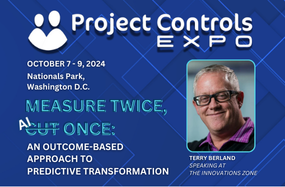
5 Best Practices for Earned Value Management Compliance

Perhaps you’ve landed a new contract valued at $50M or more and learned that this puts you at an Earned Value Management System (EVMS) threshold with Federal Acquisition Regulation (FAR) requirements. Now what? The FAR 52.234 compliance code is pages long, and you have no idea where to begin or who can help you so that you can get on with the project.
The earned value management compliance checklist can seem tremendously long. It’s a lot of work for companies with nothing in place or who have never completed EVM compliancy. If you’re a Lockheed Martin or Boeing-sized organization, you have full-stacked divisions that focus on this, with an entire dedicated group inside. But, when you’re a smaller company in the pharmaceutical, defense, or energy industries, you need help to get it right. You also must consider the complex requirements, procedures, and guidelines established by governmental agencies like the Department of Energy (413.3B), the Federal Transit Administration, or the Federal Aviation Administration (AMS 1.13-1).
But what is earned value management, you ask?
Let’s break it down. Earned value management (EVM) is a technique for objectively measuring project performance and progress. Additionally, the U.S. government runs an EVM compliance program to ensure that your finances comply with contractor EVM checklist guidelines. The federal government issues contracts at a $50M level—an organization worth $50M or more is required to show earned value compliance. At a $100M, you’re required to have an earned value system in place—and at that budget level, you get audited depending on whether you can perform according to plan.
Imagine a small pharmaceutical business just awarded an attractive government contract. While your company was chosen because of its industry-specific technical expertise, there are other hurdles that you must clear. You might have years of experience working on healthcare-related projects—for example, as a doctor with 30 years of experience—but may have no experience with this kind of federal government oversight (e.g., FAR 52.234). Furthermore, you may never have considered how to implement, demonstrate, and accurately report that the earned value management requirements have been met.
That’s where LoadSpring consultancy comes into the picture. But the nitty gritty of earned value management is a specialty area of expertise. Here’s how the pros handle it: one step at a time.
1. Evaluation of Current Environments
Before you can do anything else, you must consider the current capacity and environment in which the project will take place. If the project has already started, you can compare the estimated work value to the costs incurred thus far.
However, if the cost variance exceeds initially expected, it may be time to adjust the schedule and budget plans. Knowing what to do is only half the proverbial battle, though.
To comply with contract value requirements, you need to assess your current staff, processes, and technology and determine the investments you must make. You also must identify which cost and earned value measurement solutions you will utilize to make accurate assessments. Deltek Cobra can help predict performance and ensure the success of a project.
Your most significant advantage in managing all your applications and integrated business intelligence comes from housing all your applications in one platform. Finding the right combination of consultant and cloud-managed services partners saves you from hours of trying to find compatible vendors who can support you through the entire process. Working with trusted consultants and application experts who can help guide you to the correct formula, tool feature, or analytical insight will yield more reliable results than trying to figure it out on your own—mainly if you’ve never applied EVM formulas to a high-stakes project before.
LoadSpring’s consulting partnership with K2 Construction Consultants—similar to our consulting partnerships with TecSurge, Integrated Consulting, PRC Software, and others—offers a winning combo to help contractors with FAR 52.234 EVM contract regulations meet government compliance guidelines more quickly and easily. Because K2 is a seasoned leader in project controls and EVM contract requirements, they know how to help firms more efficiently integrate, deploy, and implement program management solutions that meet FAR EVM requirements.
2. Solution Identification & Integration
First, you must decide which technology and software application solutions you will use to record data at each project step. Then, you’ll need to know how to integrate the data housed in those applications in a cohesive, coherent manner.
Common KPIs used to measure progress on a project include project parameters, stakeholder involvement, risk, project performance, and data documentation. But what project controls should project managers put into place? For EVM-related project controls, the most critical variables include defining team roles, identifying a point of contact, determining the frequency of KPI reporting, and defining variance thresholds for schedule, budget, and cost.
These last factors are critical to EVM-related monitoring because a compliance review is most concerned with budget factors and whether an organization can contain its project within its original targeted budget and schedule. You’ll want to measure schedule variance (SV), budget variance (BV), and cost variance (CV), primarily determining whether the cause of any disagreement is typical or unique.
You’ll also want to examine change orders, mitigate scope creep, and conduct a rigorous approval process after completion. After you find the ideal applications for storing this data, the next step is determining how best to integrate all recorded information. Working with project control experts or consultants will significantly simplify the process.
3. Employee Training & Deployment
After you decide upon a system of monitoring and compliance measurement, you’ll want to make sure you have employees trained on how to ensure the deployment of your EVM plan goes smoothly.
First, it helps to recognize that strong leadership makes for a stronger team. Because of this, some recommend hiring a Project Management Office (PMO) team to train your employees—instead of simply giving them a blueprint of the EVM plan and leaving them to delegate themselves. This is because EVM plans—especially ones that will be federally audited—are increasingly larger and more complex to manage. As a result, the training of staff and deployment of resources must be performed strategically and efficiently while focused on results. EVM requires the participation of executives, program managers, control account managers, project controls experts, and finance department members, all of whom are actively engaged in the planning, operating, and reporting on the execution of the contract.
Because of significant projects’ overall increase in size and scale, smaller to medium-sized companies need a PMO lead who can oversee risks, issues, work plans, tools, and critical delivery assurance. As a result, modern PMOs regularly collaborate and meet with executive-level management to share periodic project updates and developments.
You’ll also want to enlist the help of a PMO with domain and local knowledge—along with the willingness to assume rotational lead roles among different departments to ensure continuity across the organization. It helps to outsource consultation services from knowledgeable industry veterans who can quickly assess your unique business needs. They can help you deploy your newfound EVM knowledge more efficiently.
4. Business Cycle Implementation
The next step in any comprehensive EVM process is developing, implementing, and maintaining a business cycle or schedule, including business intelligence report dashboards. You must have an EVM system if your company accepts government contract funding greater than $100M.
The business cycle or schedule development allows your organization to conduct financial EVM compliance reporting systemically. The federal government requires a monthly submittal of an expense report, which can be complex to implement.
Therefore, it helps to enlist the help of external consultants to assist your organization—especially if you are in the healthcare or pharmaceutical industry and inexperienced with filing these types of reports.
5. Hosted Schedule Management
If you’re hoping to simplify the financial reporting process so you can fully concentrate on delivering the best project imaginable, it’s wise to enlist a third party to help. Some companies opt for implementing EVM software, while others enlist the help of a hosted third-party platform that—along with BI analysts and consultants—can help ensure your schedule runs as planned.
LoadSpring works with several partners who provide consultation services. K2, for example, has 30 years of proven experience standing up and running program offices, including the following:
- Evaluation of current environments and development of compliant systems descriptions /policies/procedures/desktop instructions (GD, GE, WMATA, DCMA, USDA).
- Identification and integration of solutions required to perform effective management (GD, Fibertek, WMATA, Eagle Ray, TransCore, MDOT)
- Training and deploying employees and implementing efficient processes and technology (LM, GD, GE, WMATA, Construction Companies)
- Development, implementation, and maintenance of a business cycle/schedule, which includes business intelligence report dashboards (WMATA, DOE, LM, HP)
- Hosted schedule management services for existing customers (Accurate, Belt Built)
With these experiences and capabilities, K2 can provide a full-service PMO for small to mid-sized companies with contracts greater than $50 million that require EVM compliance. This service is invaluable because most small companies don’t have the necessary infrastructure to meet Earned Value Management Systems (EVMS) guidelines. K2 can implement the required policies and processes to ensure compliance and optimized performance.
The foundation of a fully operational, integrated solution set can tie into your EVM schedule. You’ll come to LoadSpring/K2 as a single PMO offering if you enlist our partnered services. Accessible from the LoadSpring platform, LoadSpring ProjectINTEL can also help you glean more advanced business intelligence from the data you accumulate while managing your contract.
These new data analytics insights will allow you to make more informed decisions, move forward, and become more competitive for possible future construction bids. You’ll walk away with a greater sense of data trust—and isn’t that what we all want from our data?
Contact us today to learn more about implementing more comprehensive expertise around EVM with the help of K2 and LoadSpring.








